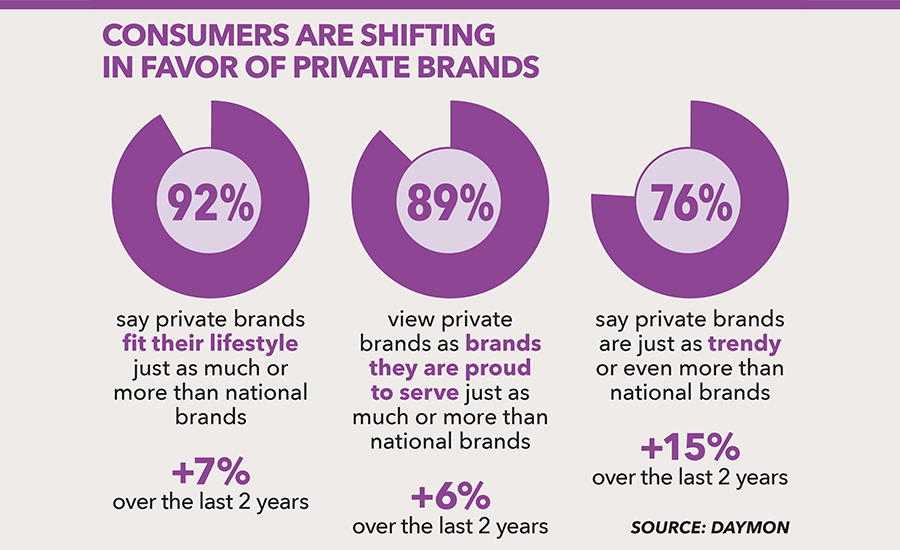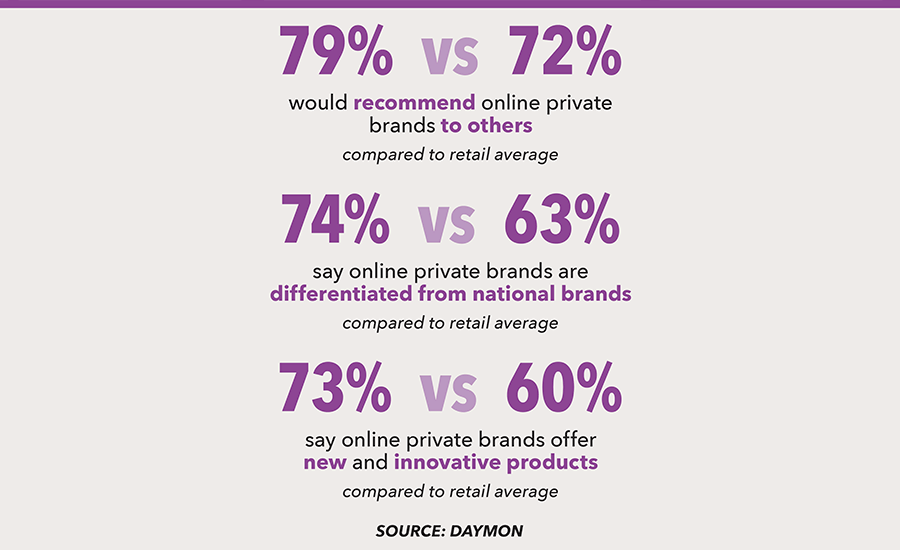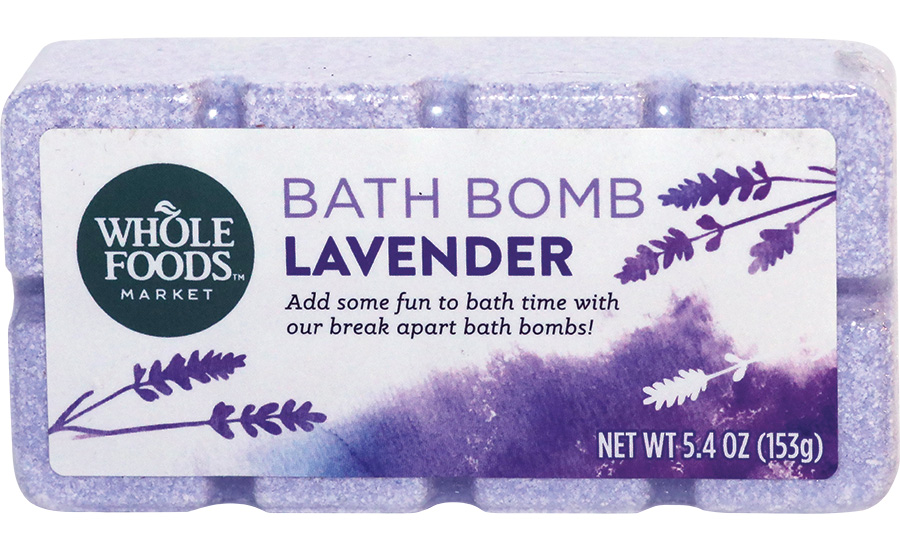Sales of private brands jumped by double digits in the first quarter of 2020 as U.S. consumers stocked up on groceries and daily essentials during the initial phase of the coronavirus pandemic, according to data from the Private Label Manufacturers Association (PLMA) and Nielsen.
In fact, in all U.S. retail outlets, private brands increased 14.6% in dollar volume and 12.8% in unit volume, just ahead of national brands that saw an increase of 11.5% in dollars and 9.2% in unit volume. Fear buying during the first half of the year led to national brands selling out on-shelf and many consumers trying store brands for the first time.
Private label manufacturers made some significant operational changes to cope with the rising demand. In categories such as paper goods, over-the counter medications and hand sanitizers, factories are operating 24-hours a day, seven days a week. Some companies are creating fair share allocations for high-demand products, while others are simplifying SKU offerings, extending lead times to build inventories and retooling to be more efficient for growing ecommerce business. The PLMA shares that even still, private label brands were still in a good place moving into 2020.
Target, for instance, has an astounding 45 “own brands,” covering food/beverage, household, pet care, fashion, personal care and more. The large chain also touts 11 exclusive brands sold only at the retail outlets. With similar and often lower prices for store brands, it’s no wonder consumers are widely accepting retail brands today.
A Commanding Force
According to Daymon’s exclusive “2020 Private Brand Survey,” private brands are enjoying almost two times more than their expected share of retail growth. Only 6% of shoppers today exclusively buy national brands, meaning virtually everyone nowadays shops private brands. And, more than one-third say that private brands comprise the majority of their shopping carts, increasing 11% over the last 2 years.
Entering into 2020, private brands were already well-positioned with shoppers, with 89% saying they trust private brands as much as national brands, and 86% viewing private brand quality as equal to or better than national brands. “At the height of the pandemic, we saw significant brand switching due to out-of-stocks and income constraints. Research shows that 70% of shoppers purchased a new or different brand as a result of COVID-19, with 28% reporting positive experiences from brand switching and planned to permanently commit,” says Jean Ryan, senior director of Brand Strategy & Design at Daymon.
With nearly one-third of U.S. families affected financially by the pandemic, the private brand proposition became even more relevant by allowing shoppers to stretch their dollars without compromising on quality. In fact, Daymon’s research shows that among those who increased their purchases of private brands during the pandemic, 53% claimed the reason was due to better pricing.
Retailers have begun to move their store brands to front of shelf and not stick them at the back like a lesser alternative. Daymon found that the strength of a retailer is correlated with its private label program, wherein three-quarters of consumers believe a retailer’s private brand is a direct reflection on the retailer.


In-Store Departments
Over the last three years, private brand share grew 88% of categories across the store aisles. There are opportunities to carve out ownership in these categories through private brands, as consumers seek a range of product attributes as part of their purchase, rather than just seeking out specific brands. Daymon’s department-level analysis finds that fresh foods in particular is emerging as a key area of growth, representing a clear shift in the private brand paradigm historically grounded in center-store commodities. In fact, 2019 saw private brands grow faster in fresh than in center store, +4.5% compared to +3.3%, respectively. Daymon also shares that over 5 in 10 consumers would like to see more store brand items in the fresh department.
The top three growth areas in the fresh category are: fresh seafood, prepared foods and produce. In the center-store category: wine/spirits, pet and facial care.
Clearly, this is a much different landscape for private brands, with progressive retailers setting the tone for the industry.
“Growth in health and beauty care was also notable, seeing over a 20% lift in unit volume during peak pandemic to address increased focus on self-care routines,” says Ryan. Beyond functional hygiene items, sales for products that help consumers pamper and indulge themselves, such as bath additives and skincare grew during this time to address both physical and emotional well-being. As we have seemingly entered into a second wave of the pandemic, Daymon expects these trends to continue as shoppers seek value-add solutions for their new priorities, all while allowing them to stretch their dollars more effectively.

Making a Beeline to the Finish Line
Most retailers know that the first step to capitalize on category opportunities is to beat other brands to market with product innovation. Daymon’s analysis of private brand programs across the country reveals that best-in-class retailers dedicate 43% of their private label programs to value-added lifestyle items, compared to the industry average of only 16%. This approach creates a healthy environment for private brands to stay on-trend and evolve well beyond the norms of the industry.
Make sure not to skip ecommerce. Retailers should include their own brands on ecommerce platforms and online shopping sites. The COVID-19 pandemic has shown us how relevant adding products to ecommerce platforms are, as most consumers were stuck at home with stay-at-home orders. Even before this, private brands had annual online sales of $1.7 billion in 2019 — an 87% increase year to year.

4 Actions for Future Success
Daymon shares four ways to success from its Private Label Playbook:
1. Rethink departments around private brands: Establish your brands as fundamental pillars of category planning. This requires the proper prioritization, merchandising techniques and approach to new item integration. With greater flexibility than national brands and retailer control, private brands are uniquely positioned to address each of these challenges. The key is to determine the right role of private brands within each category and how to best leverage each tier to maximize sales and profitability.
2. Lead with private brand innovation: Shoppers have abandoned the notion that private brands must mirror their national counterparts, and instead, are allowing private brands to a path of innovation. Don’t fast-follow or develop products that mimic what’s on shelves at the store next door. Instead, follow the consumer and deliver first-to-market innovation that reflects and reinforces the principles your brand stands for. You must keep a close pulse on the consumer, get commitment from the top down, forge strong partnerships between retailers and manufacturers, and adhere to a new product development process designed to accelerate speed to shelf. Retailers need to focus on developing the right items based on changing consumer needs and supporting them to raise visibility and understanding of brand benefits.
“Consumers have given private brands permission to stake a path of innovation on their own, so don’t wait for the national brand or retailer next door to lead,” advises Ryan. The key is to ensure that private brand solutions are complementary to national brands and overall category goals in order to drive total store growth and banner loyalty, she adds.
3. Market Private Brands as True Consumer Brands: Along with the broader narrative of treating your private
brands like legacy brands comes supporting them with a comprehensive marketing strategy. Any investment you make in improving and innovating in private brands only matters if your customers know about and understand it. Taking a 360° approach that balances physical and digital marketing platforms inclusive of emerging third-party intermediaries is key to ensuring your brands can actively engage with consumers across the evolving shopping journey.
4. Extend Private Brands Beyond Borders: Jumpstarting and maintaining growth of your private brand program for the long-term requires thinking beyond the walls of your stores. Consumers’ path to purchase continues to evolve and be disrupted by technology, so consider new and creative ways to extend brands beyond the shelf to remain relevant. Winning in the future requires making investments now to bolster your ecommerce platforms and fulfillment solutions, along with exploring strategic partnerships to tap into new geographic markets.
Looking to the future, retailers need to continue this evolution away from Private Brands being mere options at shelf, to being brands in their own right, explains Ryan. With over 50% claiming to shop at a store specifically for its Private Brands, retailers have the opportunity to better leverage their store brands as drivers of store choice and loyalty. This requires:
- Following the consumer, not the competition;
- Creating an internal environment that encourages private brands to be developed in a way that leads national brands and adjusting KPIs according to brand purposes;
- Building and executing unique and consumer-centric private brand strategies against true consumer needs; and
- Maximizing private brand presence beyond the four walls of the store to align with the new path to purchase.




